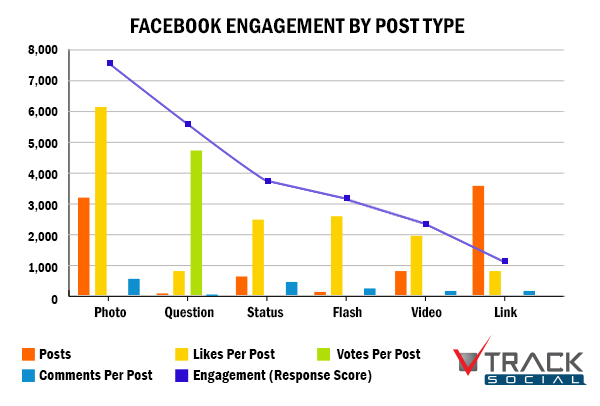 You know the old saying; a picture is worth a thousand words? According to research conducted by Social Media Today, pictures are also worth a lot of “Likes” on Facebook too. Take a look at the chart below. Both “Likes” and comments on photos are a lot more popular then posts that have links, status updates, and video. Interestingly, answering questions on Facebook are also quite popular, which signals that people still like to be engaged in more social ways and offer their opinions. #ThankGoodness
You know the old saying; a picture is worth a thousand words? According to research conducted by Social Media Today, pictures are also worth a lot of “Likes” on Facebook too. Take a look at the chart below. Both “Likes” and comments on photos are a lot more popular then posts that have links, status updates, and video. Interestingly, answering questions on Facebook are also quite popular, which signals that people still like to be engaged in more social ways and offer their opinions. #ThankGoodness
When looking at these trends it’s important to be honest about the value of someone “Liking” your organization’s status. A “Like” on a Facebook status is the equivalent of someone passively scrolling through a Facebook feed and giving you thumbs up on a post that caught their attention. That’s not real engagement though because then they move on to something new and probably shinier. This is one of the reasons why Pinterest is so addictive and successful - users continiously scroll through great photos and eye candy graphics on any topic they like and repin them.
Instragram is another great example of a network that spurs passive "Like" behavior on social media. They built a brilliant app that takes your photos and in seconds makes them look super cool by running it through one of their filters. Then the photos get published in Instragram's feed and shared on other social networks where people are prompted to "Like" it on that network too. While users certainly comment on photos on Instagram, and there is an active community of photographers and artists, Instagram's user base has signicantly expanded beyond these niche audiences. And more importantly the majority of interactions are still "Likes."
Another statistic to consider from the Social Media Today research, was how poorly video performed in generating "Likes" despite YouTube being the second most trafficked website in the U.S. “On the other hand it can certainly be said that once a fan interacts with a video, there is a deeper level of engagement, and that this can be more valuable to the brand," said Social Media Today.
The authors of the research admit that their results were "focused on the scale of engagement as opposed to the depth of individual engagement." But can you really divorce scale of engagement from depth of individual engagement? That's the problem with these types of studies. The results can easily be interpreted that a Facebook "Like" on something like a photo is an important metric that organizations should be measuring as a serious form of engagement or worse that organizations should focus on posting photos to boost "Likes." But in reality "Liking" something is actually quite passive for a channel that's supposed to be social.
How is your nonprofit using Facebook to engage people? Does Social Media Today’s study match up with your own experiences on Facebook? Tell us in the comments.




COMMENTS